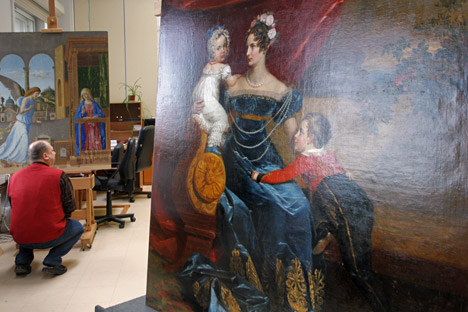
Experts believe the new secret marking system will prevent theft. Source: PhotoXPress
The Hermitage museum has started marking its collection with secret coding developed by the Russian military in order to prevent pieces from being stolen, according to director Mikhail Piotrovsky,
The museum started the secret marking system in 2006, when investigators discovered that several items from the jewelry collection had disappeared. The collections curator, Larisa Zavadskaya was blamed, but posthumously. She died of a heart attack while at work.
Officially the stolen items were estimated at 150 million rubles ($4.6 million), but some estimated that they were worth significantly more.
In order to avoid similar cases, chief curator Svetlana Adaskina announced the development of the secret marking for customs in 2007. The system was planned to mark works within two years, but it was delayed until 2013.
The reason is clear: there are more than 150,000 objects on display in the Hermitage and about 3 million in storerooms. Marking each showpiece takes several hundred hours.
According to art historian Julia Saraeva, marking an art object is not a new phenomenon.
"In the past, the system of labeling of showpieces was primitive — numbers written with oil paint, but the little things could be attached with a tag. We now have more discreet materials, but the principle is the same. If the item gets on the black market, it immediately becomes clear that the thing is stolen," she said.
In addition to better marking of museum objects, increased security is also required to prevent museum theft.
Hermitage director gives his take on museum success
Treasures of Imperial Russia on display in Moscow and St. Petersburg
Between 50 and 100 instances of museum theft are reported in Russia annually, but the number is likely much higher since works are often removed from museums with the permission of the staff. Additionally, it is fairly easy to impersonate a museum employee.
Among some of the better known thefts from Russian museums was the 1999 of works by Vasily Perov from the Russian Museum in St. Petersburg.
The stolen paintings were located on the first floor, and the thieves, led by 29-year-old Dmitry Rukavicyn simply knocked out window panes. When museum guards went after them, the thieves responded with gunfire and escaped.
This year, a museum was robbed in Vyazniky in the Vladimir region. The thieves made off with paintings by Shishkin, Korovin and Zhukovsky after they museum guard forgot to turn on the alarm system for the night.
In the Altai Region town of Regina, a woman stole a jar containing the embryos of Siamese twins from the local museum. She was detained, but the Siamese twins were not recovered.
Ilya Wolf, director general of the company Fine Art Way, which transports artworks, said that when it comes to preventing smuggling through customs, Russia should consider radiation control.
"If you consider this option, all work can be microisotoped. In addition we can pass an olfactory control: when the dogs sniff the explosives or drugs. In theory, it can be assumed that the showpieces are sprayed with a special composition," he said. "I strongly doubt that criminals won't know exactly how the works of art are marked. Therefore, they will be able to avoid customs, this is contraband."
All rights reserved by Rossiyskaya Gazeta.
Subscribe
to our newsletter!
Get the week's best stories straight to your inbox